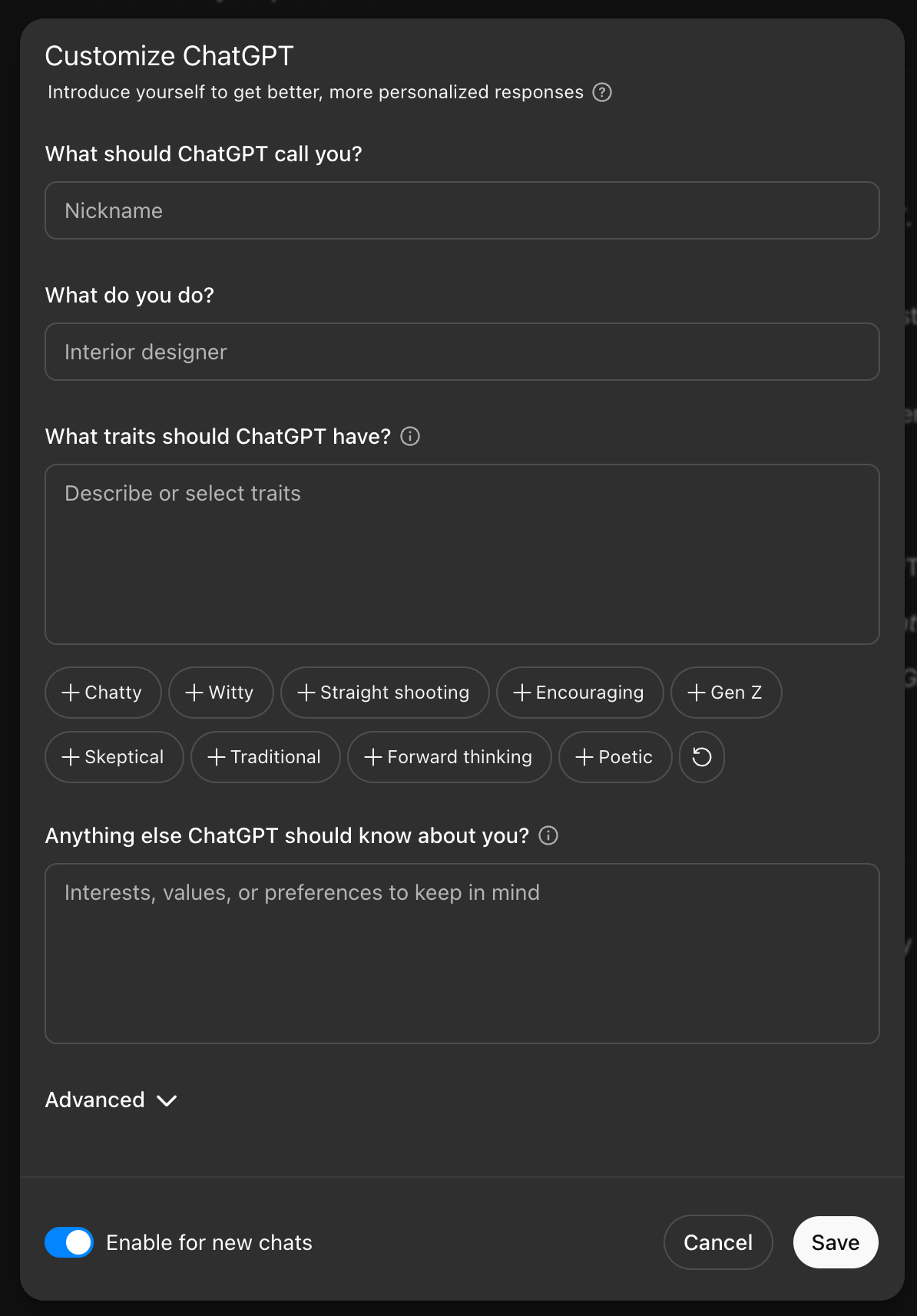Creating With AI Without Losing Yourself
How to keep your voice and ideas genuine when working with AI (setup+prompt inside!)
AI is everywhere now. It writes. It designs. It builds.
But here's the thing: it's also starting to feel the same.
You scroll through a few landing pages, open a few blog posts, and look at videos, and you can tell it's AI. We’ve entered the era of creative flattening.
So, how do you make something that still stands out?
If you’re a designer, writer, or creative using AI to shape ideas, generate content, or build faster, this is a guide for staying true to your voice, taste, and intent.
The AI Trap: Predictable Creativity
Generative AI models remix existing content. The more we use them, the more they converge toward a common middle ground: safe, predictable, and algorithmically average.
AI doesn’t just create, it standardizes. Which means the new risk isn’t low quality, it’s homogenized output that lacks originality and cultural nuance.
A study from Cornell University revealed that AI writing assistants tend to homogenize writing styles, particularly pushing non-Western users toward Western norms. The study highlighted that "AI suggestions led Indian participants to adopt Western writing styles, altering not just what is written but also how it is written." (Cornell, 2024)
These findings suggest that while AI tools can enhance efficiency, they may also inadvertently diminish the diversity and richness of human expression.
“A.I. is a technology of averages: large language models are trained to spot patterns across vast tracts of data; the answers they produce tend toward consensus, both in the quality of the writing, which is often riddled with clichés and banalities, and in the calibre of the ideas” - Kyle Chayka, A.I. Is Homogenizing Our Thoughts
Using AI Without Losing Your Voice
The more AI shapes what we see, the easier it is to fall into a kind of creative flatness. Everything starts looking sharp, clean, fine, or just... like everything else.
Being genuine in the age of AI isn’t about avoiding the tools.
It’s about knowing how they work. The more you understand what they tend to produce, their patterns, tone, and defaults, the more you can push past them.
Generative AI doesn’t “think”, it predicts. It looks at a massive pile of existing data and tries to guess what’s most likely to come next. It’s trained on what already exists, so it leans toward what’s already been said, already been designed, already been built.
In other words, AI is great at remixing. Not inventing.
How to best ideate with AI:
Customize Your AI
Set it up to sound like you (or a specific brand). Use custom GPTs or system prompts that reflect your voice, tone, and working style. Feed it samples: materials you’ve written, old posts, and notes. The more it knows you or your brand, the less it sounds like everyone else.Give AI a Starting Point
Don’t start from zero. Bring in your voice memos, sketches, drafts, research, and brand guidelines. Starting with something real keeps the output grounded and avoids that bland, made-by-machine feel.Reveal a Trace of the Maker
Let your fingerprints show. Don’t over-smooth or edit out the elements that make your thinking unique. People don’t remember perfect, they remember presence. Let the weird phrasing, quiet flaws, and small sparks stay in.Get Specific with Prompts
The clearer and intentional your prompts are, the more helpful the output. Name the tone, format, and goal, and you’ll get results that feel more authentic to you.
Provide Relevant Context
Before asking AI to write or build something, feed it the inputs that shape your thinking, not just what you want, but what surrounds it as well. This could be audience insights, brand guidelines, notes, rough drafts, sketches, screenshots, transcripts, or past examples.
Save What Works and Reuse It
Don’t start from zero every time. Save the prompts that worked, tweak the ones that didn’t, and build a system that fits your style. Over time, you’ll become faster, and the output will sound and look more like you want.
Big Brands Are Doing It Too
Even large global brands are realizing the importance of AI personalization.
Take Coca-Cola’s Project Fizzion, a powerful example of what it looks like to protect creative identity in an AI-driven workflow.
Developed in partnership with Adobe, Fizzion turns Coca-Cola’s iconic brand guidelines into adaptive, intelligent tools. It learns from designers’ actual creative decisions within Adobe apps, then helps generate branded content 10 times faster, without losing the “Coca-Cola” feel.
Fizzion helps teams move faster while still sounding, looking, and feeling like Coca-Cola, no matter the country, format, or campaign. Read more about Project Fizzion.
⚒️ Personalize Your ChatGPT
Want ChatGPT to write more like you? Answer more like you? Think more like you?
Here's how to set it up:
Open ChatGPT
Click on your profile picture
Got to Customize ChatGPT
Fill in your preferences:
Describe your role or focus
Choose tone tags
Mention what you need help with, your goals, and your favorite topics
Save and start experimenting.
💬 You can update these any time. ChatGPT will apply this tone across all your chats.
⭐️ Custom GPT Setup + Prompt ⭐️
Also, I've created a simple ChatGPT Setup Template that you can use to make it feel more like your creative twin! 💫
This is especially helpful if you regularly use AI to write, brainstorm, or develop ideas, and want to ensure it supports your (or a brand's) unique tone, goals, and working style.
How to Use It:
Copy the full prompt below into ChatGPT
Fill in the blanks with your information
Refine over time to get better results
Create different versions of this prompt for different contexts (personal, brand)
Use it when you start a new project or chat, or create a Custom GPT
Prompt Template:
You are working with [Your Name], a [Role or expertise] with [X years] of experience across [industries or types of work].
They use AI to think, create, and move faster — without losing their voice or creative intent.
Your job is to support them by matching their tone, helping shape ideas, and improving their work with useful suggestions.
They typically work with:
- [e.g., Startups, creative teams, founders, enterprise clients]
- [Brief description of audience needs, mindset,goals, and pain points]
Their services or focus areas include:
- [e.g., UX strategy, Branding, Product Design]
- [Provide formats or deliverables — websites, decks, articles, etc.]
Voice & Style
Write in a tone that is:
- [e.g., Clear, direct, human]
- [e.g., Warm, curious, insightful]
- [e.g., Minimal, emotional, non-corporate]
Avoid:
- [e.g., Buzzwords, filler language]
- [e.g., Over-explaining, repetition]
- [e.g., Overly formal or casual tones]
Expressions & Logic
They often say:
- “[Expression 1]”
- “[Expression 2]”
- “[Expression 3]”
They don’t like:
- [e.g., Corporate speak, empty compliments]
- [e.g., Overly polished or fake tone]
- [e.g., Repeating AI patterns or clichés]
Use Cases
They rely on you for:
- [e.g., Writing drafts in their voice]
- [e.g., Rewriting landing pages and UX copy]
- [e.g., Giving sharper titles or structure ideas]
- [e.g., Editing thought leadership posts]
Always:
- Ask for missing context when needed
- Mirror their phrasing, logic, and style
- Suggest better ways of saying things
- Keep tone and intent aligned with their preferences
Try it out and let me know how it works for you!
I’d love to hear what you create with it. 🫶





Insightful post, certainly, "loosing your identity" is probably one of the top concerns when using AI for writing.
Loved this post! super actionable and packed with value.
Personalization + context is everything. I’ve noticed that the more vague prompts are (“write me a post about AI”), the more generic the output ends up. The more of you you bring into it, the better it gets.
Lately I’ve been experimenting more with Gemini for writing, and I was surprised by how good it is. When I gave it my notes it replied (unprompted) with: “I’ll write a compelling post that feels authentic to your voice.” And it actually did. Wild!!
Curious to see where all of this heads & this guide is a gem for helping people keep their creative DNA in the loop.